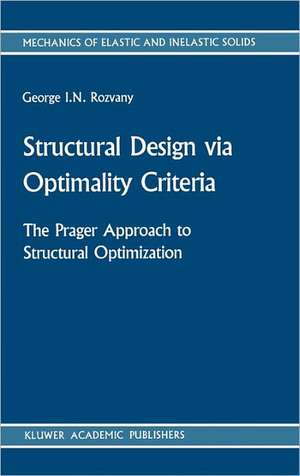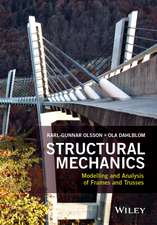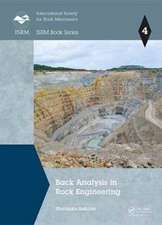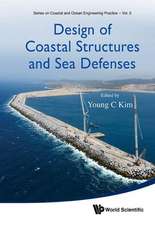Structural Design via Optimality Criteria: The Prager Approach to Structural Optimization: Mechanics of Elastic and Inelastic Solids, cartea 8
Autor George I. N. Rozvanyen Limba Engleză Hardback – 31 mar 1989
| Toate formatele și edițiile | Preț | Express |
|---|---|---|
| Paperback (1) | 1226.24 lei 6-8 săpt. | |
| SPRINGER NETHERLANDS – oct 2011 | 1226.24 lei 6-8 săpt. | |
| Hardback (1) | 1232.41 lei 6-8 săpt. | |
| SPRINGER NETHERLANDS – 31 mar 1989 | 1232.41 lei 6-8 săpt. |
Preț: 1232.41 lei
Preț vechi: 1502.94 lei
-18% Nou
Puncte Express: 1849
Preț estimativ în valută:
235.82€ • 246.84$ • 196.28£
235.82€ • 246.84$ • 196.28£
Carte tipărită la comandă
Livrare economică 31 martie-14 aprilie
Preluare comenzi: 021 569.72.76
Specificații
ISBN-13: 9789024736133
ISBN-10: 9024736137
Pagini: 490
Ilustrații: 490 p.
Dimensiuni: 155 x 235 x 27 mm
Greutate: 0.87 kg
Ediția:1989
Editura: SPRINGER NETHERLANDS
Colecția Springer
Seria Mechanics of Elastic and Inelastic Solids
Locul publicării:Dordrecht, Netherlands
ISBN-10: 9024736137
Pagini: 490
Ilustrații: 490 p.
Dimensiuni: 155 x 235 x 27 mm
Greutate: 0.87 kg
Ediția:1989
Editura: SPRINGER NETHERLANDS
Colecția Springer
Seria Mechanics of Elastic and Inelastic Solids
Locul publicării:Dordrecht, Netherlands
Public țintă
ResearchCuprins
I.1 Why Optimality Criteria?.- I.2 Classes of Problems in Structural Optimization.- I.3 Case Studies Involving Simple Structures.- I.4 Case Studies Involving More Complex Structures.- I.5 Broader Implications of Optimality Criteria Methods.- 1. Static-Kinematic Optimality Criteria.- 1.1 Aims.- 1.2 An Introductory Example: What This Book Is All About.- 1.3 Plastic Design on the Basis of the Lower Bound Theorem.- 1.4 Basic Variables in Structural Mechanics.- 1.5 Fundamental Relations of Structural Mechanics.- 1.6 The Role of Static-Kinematic Optimality Criteria.- 1.7 The Prager-Shield Theory of Optimal Plastic Design.- 1.8 The G-Gradient Operator.- 1.9 Extensions of the Prager-Shield Theory in Plastic Design.- 1.10 Optimal Elastic Design — Static Problems.- 1.11 Optimal Elastic Design — Buckling and Natural Frequency Constraints.- 1.12 Superposition Principles.- 1.13 Duality Principles in Elastic Design.- 1.14 Concluding Remarks.- 2. Optimal Plastic Design of Beams with Freely Variable Cross-Sectional Dimensions.- 2.1 General Concepts.- 2.2 Optimal Plastic Design of Beams Having a Moment-Dependent Specific Cost Function — Continuously Variable Cross-Section.- 2.3 Optimal Plastic Design of Beams Having a Moment and Shear Dependent Specific Cost Function — Continuously Variable Cross-Section.- 2.4 Dual Formulation for Plastically Designed Beams — Continuously Varying Cross-Section.- 2.5 Concluding Remarks.- 3. Optimal Plastic Design of Beams with Unspecified Actions or Reactions.- 3.1 Preliminary Remarks.- 3.2 External Actions (Reactions) at Prescribed Locations.- 3.3 External Actions or Reactions of Unspecified Location.- 3.4 Concluding Remarks.- 4. Optimal Plastic Design of Beams with Segmentation.- 4.1 Segmentation in Beam Design.- 4.2 Optimality Conditions forSegmented Beams with Prescribed Segment Boundaries.- 4.3 Optimization of Segmentation.- 4.4 Segmented Beams with Multiple Load Conditions.- 4.5 Concluding Remarks.- 5. Optimal Plastic Design of Beams: Allowance for Selfweight, Bounded Spatial Gradients (Niordson-Constraints) and Linear Segments.- 5.1 Introductory Remarks.- 5.2 Allowance for the Effect of Selfweight — Continuously Variable Cross-Section.- 5.3 Bounded Spatial Gradients of the Specific Cost (Niordson-Constraints).- 5.4 Beams with Segmentation and Selfweight.- 5.5 Beams with Linear Segmentation.- 5.6 Concluding Remarks.- 6. Optimal Elastic Design of Beams — Stress and Deflection Constraints.- 6.1 Optimal Elastic versus Optimal Plastic Design.- 6.2 Linearly Elastic Beams with Stress and Displacement Constraints — Freely Variable Cross-Sectional Dimensions.- 6.3 Prescribed Distribution of the Cross-Sectional Parameters over Given Beam Segments.- 6.4 Concluding Remarks.- 7. Optimal Elastic Design of Beams — Optimization of Segmentation, Constraints on Spatial Gradients (Niordson-Constraints) and Multicriteria Design.- 7.1 Introductory Remarks.- 7.2 Optimization of Beam Segmentation and Location of Hinges and Supports.- 7.3 Optimization of Elastic Beams with Stress, Deflection and Niordson-Constraints.- 7.4 Multicriteria Optimization of Elastic Beams.- 7.5 Concluding Remarks.- 8. The Theory of Optimal Layouts and a Brief Review of Its Applications.- 8.1 Introductory Remarks.- 8.2 The Concept of Structural Universe.- 8.3 Introductory Examples.- 8.4 Classical and Advanced Layout Theories.- 8.5 Applications of the Classical Layout Theory.- 8.6 Applications of the Advanced Layout Theory.- 9. A Short History of Optimality Criteria Methods.- 9.1 The Origins of Optimality Criteria in Structural Mechanics.-9.2 Later Developments.- 9.3 Historical Notes on Optimal Layout Theory.- Closing Remarks.- Appendix. A Brief Review of Variational Methods.- A.1 Aims.- A.2 Necessary Conditions (Euler Equations) for the Minimum of a Functional — Given Boundary Conditions and No Constraints.- Problems and Solutions.- A.3 Variational Problems with Equality Constraints.- Problems and Solutions.- A.4 Transversality Conditions (Variational Problems with Variable Boundary Conditions).- Problems and Solutions.- A.5 Inequality Constraints.- Problems and Solutions.- A.6 Mixed Variational Problems.- Problems and Solutions.- A.7 Discontinuous Extremals.- Problems and Solutions.- A.8 The Rocket Problem (Variational Solution).- Selected Bibliography.- R.1 Books.- R.2 Review Papers.- R.3 Research Papers.- Name Index.
Recenzii
`This book can definitely be recommended to all those who are willing to immerse themselves in one of the most important areas of structural optimization,`
H. Eschenauer, ZFW Köln, 1990
`Das Buch kann in jedem Fall all denen empfohlen werden, die bereit sind, sich eines der wichtigen Gebiete der Strukturoptimierung einzuarbeiten.'
Zeitschrift für Flug und Weltraumforschung, 14:1/2, 1990
H. Eschenauer, ZFW Köln, 1990
`Das Buch kann in jedem Fall all denen empfohlen werden, die bereit sind, sich eines der wichtigen Gebiete der Strukturoptimierung einzuarbeiten.'
Zeitschrift für Flug und Weltraumforschung, 14:1/2, 1990




























